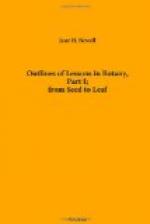[Footnote 1: See page 46.]
[Footnote 2: If elements of the same kind are untied, they constitute a tissue to which is given the name of those elements; thus parenchyma cells form parenchyma tissue or simply parenchyma; cork-cells form cork, etc. A tissue can therefore be defined as a fabric of united cells which have had a common origin and obeyed a common law of growth.—Physiological Botany. p. 102.]
[Footnote 3: See page 58.]
We will now examine our series of branches. The youngest twigs, in spring or early summer, are covered with a delicate, nearly colorless skin. Beneath this is a layer of bark, usually green, which gives the color to the stem, an inner layer of bark, the wood and the pith. The pith is soft, spongy and somewhat sappy. There is also sap between the bark and the wood. An older twig has changed its color. There is a layer of brown bark, which has replaced the colorless skin. In a twig a year old the wood is thicker and the pith is dryer. Comparing sections of older branches with these twigs, we find that the pith has shrunk and become quite dry, and that the wood is in rings. It is not practicable for the pupils to compare the number of these rings with the bud-rings, and so find out for themselves that the age of the branch can be determined from the wood, for in young stems the successive layers are not generally distinct. But, in all the specimens, the sap is found just between the wood and the bark, and here, where the supply of food is, is where the growth is taking place. Each year new wood and new bark are formed in this cambium-layer, as it is called, new wood on its inner, new bark on its outer face. Trees which thus form a new ring of wood every year are called exogenous, or outside-growing.
Ask the pupils to separate the bark into its three layers and to try the strength of each. The two outer will easily break, but the inner is generally tough and flexible. It is this inner bark, which makes the Poplar and Willow branches so hard to break. These strong, woody fibres of the inner bark give us many of our textile fabrics. Flax and Hemp come from the inner bark of their respective plants (Linum usitatissimum and Cannabis sativa), and Russia matting is made from the bark of the Linden (Tilia Americana).
We have found, in comparing the bark of specimens of branches of various ages, that, in the youngest stems, the whole is covered with a skin, or epidermis, which is soon replaced by a brown outer layer of bark, called the corky layer; the latter gives the distinctive color to the tree. While this grows, it increases by a living layer of cork-cambium on its inner face, but it usually dies after a few years. In some trees it goes on growing for many years. It forms the layers of bark in the Paper Birch and the cork of commerce is taken from the Cork Oak of Spain. The green bark is of cellular tissue,




